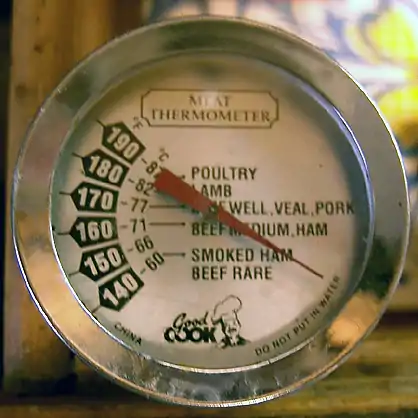Doneness
Doneness is a gauge of how thoroughly cooked a cut of meat is based on its colour, juiciness, and internal temperature when cooked. The gradations of cooking are most often used in reference to beef (especially steaks and roasts) but are also applicable to veal, pork, lamb, poultry, and seafood (but not fish).
Gradations, their descriptions, and their associated temperatures vary regionally, with different cuisines using different cooking procedures and terminology. For steaks, common gradations include rare, medium rare, medium, medium well, and well done.[1][2]
Temperature
The United States Department of Agriculture recommends an internal temperature of at least 145 °F (63 °C) for cuts of beef, veal, and lamb in order to prevent foodborne illness, and warns that color and texture indicators are not reliable.[3] The same meats should be thoroughly cooked to 160 °F (71 °C) when ground or tenderized by cutting, since these processes distribute bacteria throughout the meat.
The table below is from an American reference book[4] and pertains to beef and lamb.
| Term (French) | Description | Temperature range[4] | USDA recommended[3] | |
|---|---|---|---|---|
| Extra-rare or Blue (bleu) | very red | 46–49 °C | 115–125 °F | |
| Rare (saignant) | red center; soft | 52–55 °C | 125–130 °F | |
| Medium rare (à point) | warm red center; firmer | 55–60 °C | 130–140 °F | |
| Medium (demi-anglais) | pink and firm | 60–65 °C | 140–150 °F | 145 °F and rest for at least 3 minutes |
| Medium well (cuit) | small amount of pink in the center | 65–69 °C | 150–155 °F | |
| Well done (bien cuit) | gray-brown throughout; firm | 71 °C+ | 160 °F+ | 160 °F for ground beef |
| Overcooked (trop cuit) | blackened throughout; hard | >71 °C | >160 °F | |
The interior of a cut of meat will still increase in temperature by 3–5 °C (5–9 °F) after it is removed from an oven or other heat source as the hot exterior continues to warm the comparatively cooler interior. The exception is if the meat has been prepared in a sous-vide process, as it will already be at temperature equilibrium. The temperatures indicated above are the peak temperatures in the cooking process, so the meat should be removed from the heat source when it is a few degrees cooler.
The meat should be allowed to "rest" for a suitable amount of time (depending on the size of the cut) before being served. This makes it easier to carve and makes its structure firmer and more resistant to deformation. Its water-holding capacity also increases and less liquid is lost from the meat during carving.[5](p165)
Color
.jpg.webp)

As meat is cooked, it turns from red to pink to gray to brown to black (if burnt), and the amount of myoglobin and other juices decreases. The color change is due to changes in the oxidation of the iron atom of the heme group in the myoglobin protein. Raw meat is red due to the myoglobin protein in the muscles, not hemoglobin from blood (which also contains a heme group, hence the color). Prior to cooking, the iron atom is in a +2 oxidation state and bound to a dioxygen molecule (O2), giving raw meat its red color. As cooking proceeds, the iron atom loses an electron, moving to a +3 oxidation state and coordinating with a water molecule (H2O), which causes the meat to turn brown.
Searing raises the meat's surface temperature to 150 °C (302 °F), yielding browning via the caramelization of sugars and the Maillard reaction of amino acids. If raised to a high enough temperature, meat blackens from burning.
Drying
Well done cuts, in addition to being brown, are drier than other cuts and contain few or no juices. Note that searing (cooking the exterior at a high temperature) in no way "seals in the juices", since water evaporates at the same or higher rates as it does in unseared meat.[6] However, searing does play an important role in browning, which is a crucial contributor to flavor and texture.
See also
References
- "Degrees of Doneness". Iowa Beef Industry Council. Archived from the original on 2016-03-24. Retrieved 2016-03-17.
- Internal Color and Tenderness of the Infraspinatus, Longissimus Thoracis, and Semimembranosus are Affected by Cooking Method and Degree of Doneness. ProQuest. 2008. pp. 2–. ISBN 978-0-549-96484-1.
- "Beef from Farm to Table" (PDF). U.S. Department of Agriculture, Food Safety and Information Service. February 2003. Retrieved 2016-03-17.
- Green, Aliza (2005). Field Guide to Meat. Philadelphia, PA: Quirk Books. pp. 294–295. ISBN 1594740178.
- McGee, Harold (2004). On Food and Cooking: The Science and Lore of the Kitchen. New York, New York: Scribner. ISBN 978-0-684-80001-1. LCCN 2004058999. OCLC 56590708.
- McGee, Harold (April 20, 1992). The Curious Cook: More Kitchen Science and Lore. John Wiley & Sons. pp. 339. ISBN 0-02-009801-4.
Further reading
- Burton, Susan (June 16, 2010), "Shoe-Leather Reporting: A history of well-done meat in America.", Slate
- The Culinary Institute of America (2011). The Professional Chef (9th ed.). Hoboken, New Jersey: John Wiley & Sons. p. 367. ISBN 978-0-470-42135-2. OCLC 707248142.
